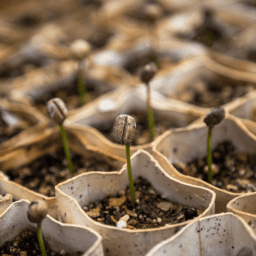Unroasted coffee beans, also known as green coffee beans, are the raw seeds extracted from coffee cherries. Before undergoing the roasting process, these beans are cleaned and processed, either through dry or wet methods, to remove the fruit and mucilage, leaving the green seed intact.
The key characteristics of unroasted coffee beans include their green color, hard texture, and lack of the characteristic coffee aroma and flavor that develops during roasting. These beans play a crucial role in coffee production, serving as the base from which all coffee products are derived. Their quality significantly impacts the flavor development of the coffee, making the selection and treatment of green coffee beans a critical step in the journey from cherry to cup.
Differentiating Unroasted and Roasted Coffee Beans
The transformation from unroasted to roasted coffee beans involves significant physical and chemical changes, impacting everything from aroma and flavor to color and acidity. Unroasted beans are green, hard, and have a grassy or woody aroma, with little to no coffee flavor.
Upon roasting, they undergo a dramatic shift, developing a rich aroma and flavor spectrum ranging from fruity and floral to chocolaty and nutty, depending on the roast level and origin. The color transition from green to various shades of brown is one of the most noticeable changes, alongside the development of a crunchy texture.
In terms of chemical composition, unroasted beans are highly acidic and contain higher levels of certain compounds, such as chlorogenic acids, which are partially broken down during roasting. The roasting process also reduces the bean’s acidity, making the coffee more palatable. Regarding processing time, unroasted beans require additional steps before consumption, including roasting, cooling, and grinding, whereas roasted beans can be ground and brewed directly.
The differences between unroasted and roasted coffee beans significantly affect coffee quality and shelf life. Unroasted beans, when stored properly, have a much longer shelf life than roasted beans, which begin to lose their flavor and aroma shortly after roasting, highlighting the importance of timely roasting and consumption for the freshest coffee experience.
Popular Varieties of Unroasted Coffee Beans
Exploring the diverse world of unroasted coffee beans reveals a plethora of varieties each with unique characteristics and flavor profiles.
Among the most esteemed are the Costa Rica Dota Estate, known for its bright acidity and complex flavor notes that range from citrus to caramel; Blue Horse 100% Kona Coffee, a Hawaiian treasure offering a smooth, rich taste with hints of nuts and berries; Sumatra Gayo, celebrated for its full body, earthy undertones, and spicy finish; and 100% Colombian Supremo, which stands out for its balanced body, mild flavor, and a touch of fruity sweetness.
The flavor and quality of these varieties are influenced by several factors, including the altitude at which the coffee is grown, soil composition, climate, and processing methods. Altitude, for instance, can enhance the beans’ acidity and flavor complexity, while the soil and climate contribute to the coffee’s unique taste characteristics. The method used to process the coffee after harvesting—whether washed, natural, or honey—also plays a significant role in defining the final flavor profile of the beans.
Advantages of Opting for Unroasted Coffee Beans
Choosing unroasted coffee beans offers several advantages, starting with the opportunity to experience coffee at its freshest. Roasting coffee beans triggers the Maillard reaction and caramelization, unlocking the aromatic oils and flavors that define the coffee’s character. By roasting beans at home, enthusiasts can enjoy coffee at its peak freshness, capturing the full spectrum of flavors and aromas that pre-packaged coffee may lack due to the inevitable delay from roasting to brewing.
Economically, unroasted beans are often more affordable than their roasted counterparts. This price difference is attributable to the additional processing, packaging, and marketing costs associated with roasted coffee.
Furthermore, unroasted beans boast a longer shelf life, extending up to a year when stored properly, compared to the few weeks to a month that roasted beans maintain their optimum quality. This longevity allows consumers to buy in bulk without worrying about the beans losing their flavor, translating to long-term savings and reduced waste.
The flexibility that unroasted coffee beans offer is another compelling benefit. Roasting at home allows coffee aficionados to experiment with roast levels, from light and fruity to dark and bold, tailoring the coffee to their personal preference. This hands-on approach to coffee preparation not only enhances the drinking experience but also provides a deeper understanding of the factors that influence coffee flavor, creating a more intimate and rewarding relationship with the beloved beverage.
Criteria for Selecting High-Quality Beans
When selecting unroasted coffee beans, look for uniformity in size and color, as these are indicators of quality processing and sorting. Beans should be free from visible defects such as cracks, holes, or excessive chipping. The origin and variety of the beans can also guide your selection, with specific regions known for producing beans with distinctive flavors and aromas.
Additionally, consider the harvest date—fresher beans, usually within a year of harvest, offer the best potential for flavor development upon roasting.
Best Practices for Storage to Maintain Freshness and Quality
To preserve the freshness and quality of unroasted coffee beans, store them in a cool, dry place away from direct sunlight and moisture. Use airtight containers to protect the beans from air and moisture, which can significantly degrade their quality.
Avoiding extreme temperatures and fluctuations extends their shelf life and maintains their inherent flavor profiles. Proper storage can keep unroasted coffee beans fresh for up to a year, ensuring they remain in optimal condition until you’re ready to roast.
Overview of Equipment Needed for Home Roasting
Home roasting requires minimal equipment, with options ranging from simple pan roasting on the stove to using specialized coffee roasting machines. A dedicated coffee roaster, while not essential, provides the most control and consistency. These machines vary from small, fluid bed roasters suitable for beginner home roasters to more advanced drum roasters that allow for larger batches and more detailed roast profiles.
Step-by-Step Guide to Roasting Coffee at Home
- Preheat your roasting equipment according to the manufacturer’s instructions.
- Measure the desired amount of unroasted beans.
- Begin roasting, monitoring the color, aroma, and sound of the beans for cues on the development stage.
- Cool the beans immediately after reaching your desired roast level to stop the roasting process.
- Allow the roasted beans to degas for several hours to a few days before grinding and brewing.
Tips for Achieving Desired Roasting Levels
Start by understanding the stages of roast from light to dark, and use a thermometer or roaster with a temperature gauge to monitor the process. Listen for the “first crack,” an audible sign that occurs as beans expand, indicating a light to medium roast. Continuing past the first crack towards the “second crack” will achieve a medium to dark roast. Experimentation and note-taking can help refine your technique and achieve consistent results.
Explanation of Light, Medium, Medium-Dark, and Dark Roasts
Roast levels range from light, which highlights the original flavors of the bean, to dark, which emphasizes richer, more caramelized flavors. Light roasts have a light brown color, medium roasts are medium brown with a balanced flavor, medium-dark roasts have a richer, darker color with some oil on the bean surface, and dark roasts are shiny and black, offering a bold flavor profile.
Discussion on How Roast Levels Affect Caffeine Content and Flavor
Contrary to popular belief, the caffeine content in coffee slightly decreases as the roast gets darker, though the difference is minimal. Light roasts can retain a higher concentration of caffeine but exhibit acidic and fruity flavor notes, while dark roasts offer a smoother taste with less acidity. The roast level significantly influences the coffee’s flavor profile, with lighter roasts preserving more of the bean’s original characteristics and darker roasts introducing deeper, smokier flavors.
FAQs
How do I select the best unroasted coffee beans? Look for beans with uniform size and color, indicating quality processing. Choose beans based on preferred flavor profiles linked to their origin, and always check for freshness.
What is the best way to store unroasted coffee beans? Store unroasted beans in a cool, dry place, away from sunlight and moisture. Use airtight containers to preserve their quality and extend shelf life up to a year.
Can I roast coffee beans at home without special equipment? Yes, you can use a pan on the stove, but for more consistent results, consider a dedicated coffee roasting machine.
What are the signs that coffee beans have been roasted properly? Listen for the “first crack” for light to medium roasts and the “second crack” for darker roasts. The beans should change color accordingly, from light brown to dark, and develop a rich aroma.
Conclusion
Throughout this article, we have explored the intricate world of unroasted coffee beans, from selecting high-quality varieties to the nuances of home roasting. We’ve highlighted the significance of proper storage and the advantages of roasting beans at home, such as freshness, economic benefits, and the joy of flavor experimentation.
By understanding the different roast levels and their impact on flavor and caffeine content, coffee enthusiasts are empowered to craft a truly personalized coffee experience. Embracing the process of selecting, storing, and roasting unroasted coffee beans not only deepens one’s appreciation for coffee but also opens the door to a world of rich, customizable flavors.









